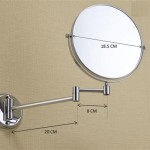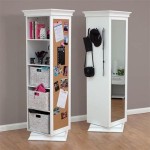Make Your Own LED Vanity Mirror
A well-lit vanity mirror is essential for applying makeup, styling hair, and performing other grooming tasks. While commercially available LED vanity mirrors offer convenience, building a custom version allows for personalization of size, style, and lighting features. This article provides a comprehensive guide to constructing a DIY LED vanity mirror.
Materials Required: Several key materials are necessary for this project. These include a mirror of the desired size and shape, LED strip lights, a power supply suitable for the LED strips, wiring, a frame or casing for the mirror, mounting hardware, and tools such as a soldering iron, wire strippers, and a hot glue gun.
Choosing the Right Mirror: The mirror serves as the foundation of the project. Selecting the appropriate size and shape is crucial. Consider the available space and desired aesthetic when making this decision. Frameless mirrors are generally easier to work with for this type of project. The mirror's thickness should also be considered, ensuring it's compatible with the chosen mounting method.
Selecting LED Strip Lights: LED strip lights provide even and customizable illumination. Key factors to consider include color temperature, brightness, and length. Color temperature is measured in Kelvin (K). A lower color temperature (2700-3000K) provides a warm, yellowish light, while a higher color temperature (5000-6500K) offers a cooler, bluish-white light, often preferred for makeup application. Brightness is measured in lumens. Choose a brightness level that suits individual needs and the ambient lighting of the room. The length of the LED strip should be sufficient to encompass the perimeter of the mirror.
Power Supply Considerations: The power supply must be compatible with the chosen LED strip lights. Check the voltage and amperage requirements of the LED strips and select a power supply that meets or exceeds these specifications. Ensure the power supply is certified for safety and complies with relevant electrical regulations.
Framing and Casing: The frame or casing provides structural support and enhances the aesthetic appeal of the finished mirror. Various materials can be used, including wood, metal, or plastic. The chosen material should be easy to work with and capable of securely holding the mirror and LED strips. Consider the overall design and choose a frame that complements the existing décor.
Step-by-Step Assembly: Begin by attaching the LED strips to the back perimeter of the mirror using adhesive backing or clips. Ensure the strips are evenly spaced and aligned. Solder the wires from the LED strips to the power supply, observing correct polarity. Test the lighting setup to ensure proper functionality before proceeding. Securely mount the mirror within the chosen frame or casing. Conceal the wiring and power supply within the frame or casing for a clean and professional finish. Install mounting hardware on the back of the frame for wall hanging.
Safety Precautions: Working with electricity requires careful attention to safety. Always disconnect the power supply before working with wiring. Use appropriate safety equipment, such as insulated gloves and eye protection. Ensure all connections are secure and properly insulated to prevent shorts and electrical hazards. Follow all manufacturer instructions for the LED strips and power supply.
Customization Options: Several customization options can enhance the functionality and aesthetics of the DIY LED vanity mirror. A dimmer switch can be incorporated to adjust the brightness of the LEDs. Adding a touch sensor switch provides a modern and convenient way to control the lighting. Integrating a defogger pad prevents the mirror from fogging up in humid environments. Experimenting with different frame designs and finishes allows for personalization and customization to match individual preferences.
Maintenance and Troubleshooting: Regular cleaning of the mirror surface and frame will maintain its appearance. Use a soft cloth and a mild cleaning solution. Avoid abrasive cleaners that can scratch the mirror. If the LEDs fail to illuminate, check the power supply connection and ensure the LEDs are properly wired. Refer to the manufacturer's troubleshooting guide for specific issues related to the LED strips or power supply.
Alternatives to Traditional Frames: While traditional frames provide a classic look, alternative mounting methods can offer a unique aesthetic. Consider using adhesive clips or mounting brackets to attach the mirror directly to the wall, creating a frameless look. Reclaimed wood or repurposed materials can be used to create a custom frame with a rustic or vintage feel. Exploring different mounting and framing options allows for creative expression and personalization.

Diy Light Up Vanity Mirrors You Can Make Ohmeohmy Blog
:max_bytes(150000):strip_icc()/makesandmunchies-c136f898cca640faa72b6209012230cb.jpg?strip=all)
7 Diy Lighted Mirror Ideas To Add A Little Extra Shine Your Space

Diy Light Up Vanity Mirrors You Can Make Ohmeohmy Blog

How To Diy Vanity Mirror With Led Strip Lights

10 Diy Vanity Mirror Projects That Show You In A Diffe Light

Diy Light Up Vanity Mirrors You Can Make Ohmeohmy Blog

How To Make Your Very Own Led Vanity Mirrorbroke And Chic

Diy Light Up Vanity Mirrors You Can Make Ohmeohmy Blog

How To Diy Vanity Mirror With Led Strip Lights
:max_bytes(150000):strip_icc()/thesorrygirls2-ae3caf45a59a45488d601802c41b18e5.jpg?strip=all)
7 Diy Lighted Mirror Ideas To Add A Little Extra Shine Your Space








